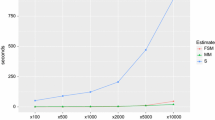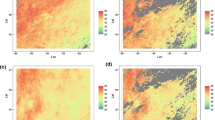Summary
Three extensions of the basic PCA and PLS methodologies are described. These extensions are hierarchical, non-linear and batch-based in nature. The objectives of these methods are to assist in problem understanding and problem solving in very complex (QSAR) problem formulations. The method extensions are illustrated using two example QSAR data sets containing many X- and Y-variables.
Similar content being viewed by others
Abbreviations
- ACE:
-
alternating conditional expectations
- BIF-PLS:
-
bifocal PLS
- MARS:
-
multivariate adaptive regression splines
- MLR:
-
multiple linear regression
- NPLS:
-
non-linear PLS
- NN:
-
neural networks
- PARAFAC:
-
parallel factor analysis
- PCA:
-
principal component analysis
- PCB:
-
polychlorinated biphenyls
- PCR:
-
principal component regression
- PLS:
-
partial least squares projections to latent structures
- OPLS:
-
orthogonal PLS
- PLS-DA:
-
PLS discriminant analysis
- QSAR:
-
quantitative structure-activity relationships
- SIMCA:
-
soft independent modelling of class analogy
- SMD:
-
statistical molecular design
- SPLS:
-
spline PLS
- SVM:
-
support vector machines
References
Eriksson, L., Andersson, P.M., Johansson, E. and Tysklind, M., Megavariate analysis of environmental QSAR data. Part I – A basic framework founded on principal component analysis (PCA), partial least squares (PLS), and statistical molecular design (SMD), 2005, This issue.
Eriksson, L., Jaworska, J., Worth, A.P., Cronin, M.T.D., McDowell, R.M. and Gramatica, P., Methods for reliability and uncertainty assessment and for applicability evaluations of classification- and regression-based QSAR, Environmental Health Perspectives, 11 (2003) 1361–1375.
Wold, S. and Dunn, III, W.J., Multivariate quantitative structure-activity relationships: Conditions for their applicability, J. Chem. Inf. Comp. Sci., 23 (1983) 6–13.
Eriksson, L. and Johansson, E., Multivariate design and modelling in QSAR, Chemom. Intell. Lab. Syst., 34 (1996) 1–19.
Wold, S., Kettaneh. N. and Tjessem, K., Hierarchical multiblock PLS and PC models for easier model interpretation and as an alternative to variable selection, Journal of Chemometrics, 10 (1996) 463–482.
Berglund, A., De Rosa, M.C. and Wold, S., Alignment of flexible molecules at their receptor site using 3d descriptors and hi-PCA, Journal of Computer-Aided Molecular Design, 11 (1997) 601–612.
Rännar, S., MacGregor, J.F. and Wold, S., Adaptive batch monitoring using hierarchical PCA, Chemometrics and Intelligent Laboratory Systems, 41 (1998) 73–81.
Westerhuis, J., Kourti, T. and MacGregor, J.F., Analysis of multiblock and hierarchical PCA and PLS models, Journal of Chemometrics, 12 (1998) 301–332.
Janné, K., Pettersen, J., Lindberg, N.-O. and Lundstedt, T., Hierarchical principal component analysis (PCA) and projection to latent structure (PLS) technique on spectroscopic data as a data pretreatment for calibration, Journal of Chemometrics, 15 (2001) 203–213.
Eriksson, L., Johansson, E., Lindgren, F., Sjöström, M. and Wold, S., Megavariate analysis of hierarchical QSAR data, Journal of Computer-Aided Molecular Design, 16 (2002) 711–726.
Gunnarsson, I., Andersson, P., Wikberg, J. and Lundstedt, T., Multivariate analysis of G-protein coupled receptors, Journal of Chemometrics, 17 (2003) 82–92.
Stefanov, Z.I. and Hoo, K.A., Hierarchical multivariate analysis of cockle phenomena, Journal of Chemometrics, 17 (2003) 550–568.
Eriksson, L., Arnhold, T., Beck, B., Fox, T., Johansson, E. and Kriegl, J.M., Onion design and its application to a pharmaceutical QSAR problem, Journal of Chemometrics, 18 (2004) 188–202.
Eriksson, L., Antti, H., Gottfries, J., Holmes, E., Johansson, E., Lindgren, F., Long, I., Lundstedt, T., Trygg, J. and Wold, S., Using chemometrics for navigating in the large data sets of genomics, proteomics and metabonomics, Analytical and Bioanalytical Chemistry, 380 (2004) 419–429.
Kettaneh, N., Berglund, A. and Wold, S., PCA and PLS with very large data sets, Computational Statistics and Data Analysis, 48 (2005) 69–85.
Hermens, J.L.M., 1989, Quantitative structure-activity relationships of environmental pollutants. In: Hutzinger, O., (Ed.), Handbook of Environmental Chemistry, Vol 2E, Reactions and Processes. Springer-Verlag, Berlin, 1989, pp. 111–162.
Könemann, H., Quantitative structure-activity relationships in fish studies. Part 1: Relationship for 50 industrial pollutants, Toxicology, 19 (1981) 209–221.
Wold, S., Kettaneh-Wold, N. and Skagerberg, B., Non-linear PLS modelling, Chemom. Intell. Lab. Syst., 7 (1989) 53–65.
Wold, S., Non-linear partial least squares modeling. II. Spline inner realation, Chemom. Intell. Lab. Syst., 14 (1992) 71–84.
Qin, S.J. and McAvoy, T.J., Non-linear PLS Modelling using neural networks, Comput. Chem. Engng., 16 (1992) 379–391.
Sekulic, S., Seasholtz, M.B., Wang, Z., Kowalski, B., Lee, S.E. and Holt, B.R, Non-linear multivariate calibration methods in analytical chemistry, Anal. Chem., 65 (1993) 835–845.
Andersson, G., Kaufmann, P. and Renberg, L, Non-linear modelling with a coupled neural network – PLS regression system, J. Chemom., 10 (1996) 605–614.
Blanco, M., Coello, J., Iturriaga, H., Maspoch, S. and Pagès, J., NIR calibration in non-linear systems: Different PLS approaches and artificial neural networks, Chemom. Intell. Lab. Systs., 50 (2000) 75–82.
Berglund, A. and Wold, S., INLR, Implicit non-linear latent variable regression, J. Chemom., 11 (1997) 141–156.
Berglund, A. and Wold, S., A serial extension of multi block PLS, Journal of Chemometrics, 13 (1999) 461–471.
Berglund, A., Kettaneh, N., Uppgård, L.L., Wold, S., Bandwell, N. and Cameron, D.R., The GIFI approach to non-linear PLS modelling, Journal of Chemometrics, 15 (2001) 321–336.
Eriksson, L., Johansson, E., Lindgren, F. and Wold, S., GIFI-PLS: modeling of non-linearities and discontinuities in QSAR, Quantitative Structure-Activity Relationships, 19 (2000) 345–355.
Michailidis, G. and de Leeuw, J., The GIFI system of descriptive multivariate analysis, Statistical Science, 13 (1998) 307–336.
Eriksson, L., Gottfries, J., Johansson, E. and Wold, S., Time-resolved QSAR: An approach to PLS modelling of three-way biological data, Chemometrics and Intelligent Laboratory Systems, 73 (2004) 73–84.
Wold, S., Kettaneh, N., Fridén, H. and Holmberg, A., Modelling and diagnostics of batch processes and analogous kinetic experiments, Chemometrics and Intelligent Laboratory Systems, 44 (1998) 331–340.
Esbensen, K. and Geladi, P., Strategy of multivariate image analysis (MIA), Chemometrics and Intelligent Laboratory Systems, 7 (1989) 67–86.
MacGregor, J.F. and Nomikos, P., Monitoring batch processes, NATO ASI for batch processing systems, May 29–June 7, 1992, Antalya, Turkey.
Kourti, T., Multivariate dynamic data modeling for analysis and statistical process control of batch processes, start-ups and grade transitions, Journal of Chemometrics, 17 (2003) 93–109.
Bro, R., PARAFAC. Tutorial and Applications, Chemometrics and Intelligent Laboratory Systems, 38 (1997) 149–171.
Kiers, H.A.L., Some procedures for displaying results from three-way methods, Journal of Chemometrics, 14 (2000) 151–70.
Nicholson, J.K., Connelly, J., Lindon, J.C. and Holmes, E., Metabonomics: a platform for studying drug toxicity and gene function, Nature Reviews, 1 (2002) 153–162.
Antti, H., Bollard, M.E., Ebbels, T., Keun, H., Lindon, J.C., Nicholson, J.K and Holmes, E., Batch statistical processing of 1H-NMR-derived urinary spectral data, Journal of Chemometrics, 16 (2002) 461–468.
Cruciani, G. and Watson, K.A., Comparative molecular field analysis using GRID force-field and GOLPE variable selection methods in a study of inhibitors of glycogen phosphorylase b, Journal of Medicinal Chemistry, 37 (1994) 2589–2601.
Cocchi, M. and Johansson, E., Amino acids characterization by grid and multivariate data analysis, Quantitative Structure-Activity Relationships, 12 (1993) 1–8.
Trygg, J. and Wold, S., Orthogonal projections to latent structures, Journal of Chemometrics, 16 (2002) 119–128.
Trygg, J., O2-PLS for qualitative and quantitative analysis in multivariate calibration, Journal of Chemometrics, 16 (2002) 283–293.
Trygg, J., Prediction and spectral profile estimation in multivariate calibration, Journal of Chemometrics, 18 (2004) 166–172.
Kristal, B.S., Practical considerations and approaches for entry-level megavariate analysis (2002). http://mickey.utmem.edu/papers/bioinformatics_02/pdfs/Kristal.pdf. Accessed 2006–01–31.
Wold, S., Hellberg, S., Lundstedt, T., Sjöström, M. and Wold, H., PLS Modeling with latent variables in two or more dimensions, Proceedings Frankfurt PLS-meeting, September, 1987.
Eriksson, L., Damborsky, J., Earll, M., Johansson, E., Trygg, J. and Wold, S., Three-block bi-focal PLS (3BIF-PLS) and its application in QSAR, SAR and QSAR in Environmental Research, 5/6 (2004) 481–499.
Martens, H., Anderssen, E., Flatberg, A., Gidskehaug, L.H., Höy, M., Westad, F., Thybo, A. and Martens, M., Regression of a data matrix on descriptors of both its rows and of its columns via latent variables: L-PLSR, Computational Statistics and Data Analysis, 48 (2005) 103–123.
Author information
Authors and Affiliations
Corresponding author
Rights and permissions
About this article
Cite this article
Eriksson, L., Andersson, P.L., Johansson, E. et al. Megavariate Analysis of Environmental QSAR Data. Part II – Investigating Very Complex Problem Formulations Using Hierarchical, Non-Linear and Batch-Wise Extensions of PCA and PLS. Mol Divers 10, 187–205 (2006). https://doi.org/10.1007/s11030-006-9026-4
Received:
Accepted:
Published:
Issue Date:
DOI: https://doi.org/10.1007/s11030-006-9026-4




